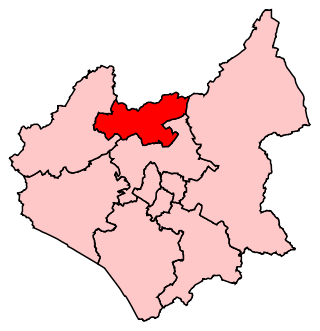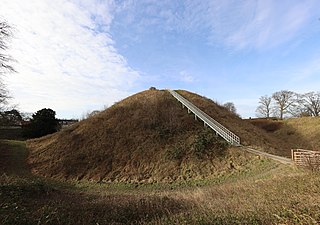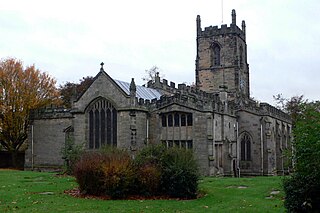
Ashby-de-la-Zouch, also spelled Ashby de la Zouch, is a market town and civil parish in the North West Leicestershire district of Leicestershire, England, near to the Derbyshire and Staffordshire borders. Its population at the 2011 census was 12,370. Ashby de la Zouch Castle was an important fort in the 15th to 17th centuries. During the 19th century, the town's main industries were ribbon manufacturing, coal mining, and brickmaking.

Ashby de la Zouch Castle is a ruined fortification in the town of Ashby-de-la-Zouch, Leicestershire, England. The castle was built by William, Lord Hastings, a favourite of Edward IV, after 1473, accompanied by the creation of a 3,000-acre (1,200 ha) park. Constructed on the site of an older manor house, two large towers and various smaller buildings had been constructed by 1483, when Hastings was executed by Richard, Duke of Gloucester. The Hastings family used the castle as their seat for several generations, improving the gardens and hosting royal visitors.

North West Leicestershire is a local government district in Leicestershire, England. The council is based in Coalville, the area's largest town. The district also contains the towns of Ashby-de-la-Zouch, Ashby Woulds and Ibstock, along with numerous villages and surrounding rural areas.

Willesley is a village and former civil parish, now in the parish of Ashby-de-la-Zouch, in the North West Leicestershire district, in the county of Leicestershire, England. It was originally in Derbyshire. Willesley Hall was the home of the Abney and later the Abney-Hastings family. In 1931 the parish had a population of 80.

Kirby Muxloe Castle, also known historically as Kirby Castle, is a ruined, fortified manor house in Kirby Muxloe, Leicestershire, England. William, Lord Hastings, began work on the castle in 1480, founding it on the site of a pre-existing manor house. William was a favourite of King Edward IV and had prospered considerably during the Wars of the Roses. Work continued quickly until 1483, when William was executed during Richard, Duke of Gloucester's, seizure of the throne. His widow briefly continued the project after his death but efforts then ceased, with the castle remaining largely incomplete. Parts of the castle were inhabited for a period, before falling into ruin during the course of the 17th century. In 1912, the Commissioners of Work took over management of the site, repairing the brickwork and carrying out an archaeological survey. In the 21st century, the castle is controlled by English Heritage and open to visitors.

A finger pillory is a style of restraint where the fingers are held in a wooden block, using an L-shaped hole to keep the knuckle bent inside the block. The name is taken from the pillory, a much larger device used to secure the head and hands.

Loughborough is a constituency in Leicestershire represented in the House of Commons of the UK Parliament since 2019 by Jane Hunt, a Conservative. From 2010 until 2019, it was represented by Nicky Morgan, who served in the governments of David Cameron and Boris Johnson. In 2020, she was elevated to the Peerage and became a member of the House of Lords. The constituency is a considered a bellwether, as it has reflected the national result at every general election since February 1974.

Launceston Castle is located in the town of Launceston, Cornwall, England. It was probably built by Robert the Count of Mortain after 1068, and initially comprised an earthwork and timber castle with a large motte in one corner. Launceston Castle formed the administrative centre of the new earldom of Cornwall, with a large community packed within the walls of its bailey. It was rebuilt in stone in the 12th century and then substantially redeveloped by Richard of Cornwall after 1227, including a high tower to enable visitors to view his surrounding lands. When Richard's son, Edmund, inherited the castle, he moved the earldom's administration to Lostwithiel, triggering the castle's decline. By 1337, the castle was increasingly ruinous and used primarily as a gaol and to host judicial assizes.

Ascot d'Oilly Castle is situated north of the village of Ascott-under-Wychwood in the north west region of Oxfordshire. It is a scheduled ancient monument. A fragment of the castle remains and is a Grade II listed building. It was named after Roger d'Oilly who was granted it by William the Conqueror and whose brother built Oxford Castle. It is thought that the castle was built around 1129 and it was demolished soon after 1175. There are fragmentary remains of a stone tower. The remains consist of raised ground surrounded by broad ditching.

Groby Castle is situated in the large village of Groby to the north-west of the city of Leicester, England.

Thetford Castle is a medieval motte and bailey castle in the market town of Thetford in the Breckland area of Norfolk, England. The first castle in Thetford, a probable 11th-century Norman ringwork called Red Castle, was replaced in the 12th century by a much larger motte and bailey castle on the other side of the town. This new castle was largely destroyed in 1173 by Henry II, although the huge motte, the second largest man-made mound in England, remained intact. The motte, recognised as a scheduled monument, now forms part of a local park, and the remains are known variously as Castle Hill, Castle Mound and Military Parade.
Watch Hill Castle is a medieval motte-and-bailey on the boundary of Bowdon and Dunham Massey, Greater Manchester, England. It is a scheduled monument. The castle is located north of the River Bollin and south of a deep ravine.
Ivanhoe School is a coeducational secondary school located in Ashby-de-la-Zouch, Leicestershire, England.

Sauvey Castle is a medieval castle, near Withcote, Leicestershire, England. It was probably built by King John in 1211 as a secluded hunting lodge in Leighfield Forest. It comprised a ringwork or shell keep, with an adjacent bailey; earthwork dams were constructed to flood the area around the castle, creating a large, shallow moat. The castle was occupied by the Count of Aumale in the early reign of Henry III, but it then remained in the control of the Crown and was used by royal foresters until it fell into disuse in the 14th century. By the end of the 17th century, its walls and buildings had been dismantled or destroyed, leaving only the earthworks, which remain in a good condition in the 21st century.

Coleorton is a village and civil parish in North West Leicestershire, England. It is situated on the A512 road approximately 2 miles (3.2 km) east of Ashby de la Zouch. Nearby villages include Newbold, to the north, Thringstone to the east, and Swannington to the south-east.

St Helen's Church is the Anglican parish church of Ashby-de-la-Zouch, in the deanery of North West Leicestershire and the Diocese of Leicester. There was a church in the town in the 11th century, but the core of the present building mainly dates from work started in 1474, when the church was rebuilt by William Hastings at the same time that he converted his neighbouring manor house into a castle. The church was refurbished in about 1670 to create more space, but the large and increasing size of the congregation led to further work in 1829, and a major rebuild in 1878–80, including the widening of the nave by the addition of two outer aisles.

The Church of St Mary Magdalene is a church in Essendine, Rutland. It is a Grade II* listed building.
The Leicestershire County Lawn Tennis Championships or simply called the Leicestershire Championships was a combined men's and women's grass court tennis tournament founded in 1900 that ran until 1914 as an open international tennis event. In 1926 the event was reclassified as a closed tournament open only to Leicestershire residents and club players only.
The Ashby-de-la-Zouch Open Championships and informally called the Ashby-de-la-Zouch Open was a men's and women's grass court tennis tournament first established in 1900. The championship was first held on courts at the Bath Grounds in Ashby-de-la-Zouch, Leicestershire, England. The tournament ran until 1926 when it was suddenly discontinued. It was revived in 1930 and continued till 1939 when it was finally abolished.






















